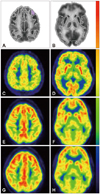Abstract
Background and Purpose
Methods
Results
Figures and Tables
 | Fig. 1Representative [F-18] FDG-PET transaxial images throughout the cortices (A, C, E and G) and mid-brain (B, D, F and H). [F-18] FDG-PET regions of interest are shown in (A) and (B) as determined by Philips NeuroQ (version 3.0) as well as corresponding locations in a representative normal brain (C and D) and one of this study's participants before (E and F) and after (G and H) Sapropterin supplementation (126 days). Note the purple shaded region in (A) designates Broca's area in which a significant increase in glucose metabolism was found in response to therapy. Tracer uptake intensity color legend is shown to the right of the images (red/yellow=highest, black/violet=lowest). Note the depressed glucose metabolism in the frontal cortices relative to the parietal cortices in the PKU patient (E-H) compared to the normal example (C and D). This pattern was present in all patients. FDG-PET: fluorodeoxyglucose positron emission tomography. |
Table 2

**p-value from Wilcoxon test.
CPT-II: Conners' Continuous Performance Test, D-KEFS: Delis-Kaplan Executive Function System Verbal Fluency subtest, HVLT: Hopkins Verbal Learning Test, PASAT: Paced Auditory Serial Addition Task, SDMT: Symbol-Digit Modalities Test, WAIS-IV: Wechsler Adult Intelligence Scale-Fourth Edition Digit Span subtest, WMS-IV: Wechsler Memory Scale-Fourth Edition Symbol Span subtest.
Acknowledgements
Notes
Can Ficicioglu, MD, PhD received research funding from Biomarin.
Jacob G Dubroff, MD, PhD, Nina Thomas, PhD, Paul R Gallagher, BS, Jessica Burfield, RD Rebecca Randall RD, Hongming Zhuang, MD, PhD report no disclosures.
Christie Hussa RD, MBA received honoraria as a speaker at a meeting organized by Biomarin.




 PDF
PDF ePub
ePub Citation
Citation Print
Print





 XML Download
XML Download